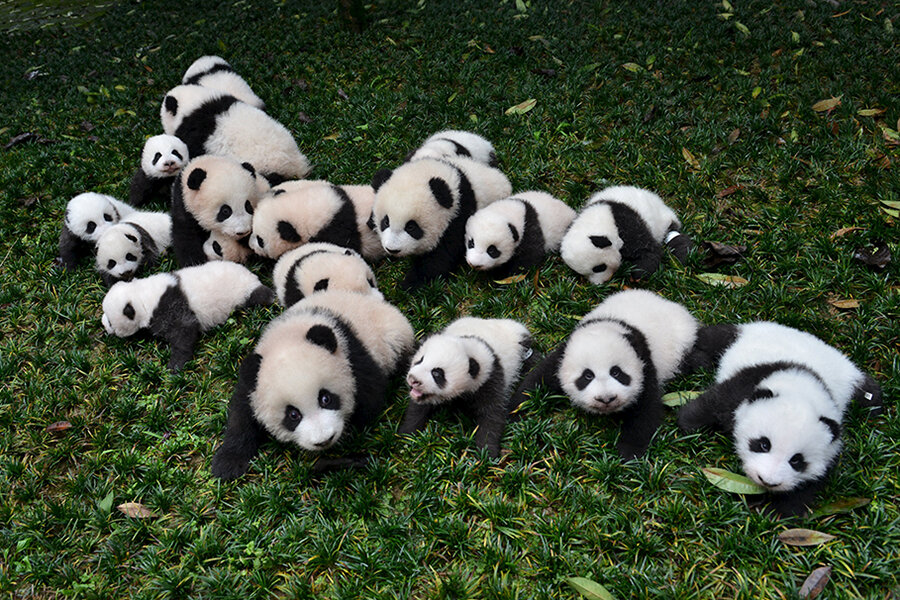Are pandas worth it?
Loading...
Richard Nixon and Mao Zedong were not the most likely matchmakers. But when Ling-Ling and Hsing-Hsing arrived at Washington, D.C.'s National Zoo in 1972, to thank Nixon for his visit to China, it set off a love affair between a doting public and a doe-eyed, rather listless creature that's now transcended time and borders.
Germany is the latest beneficiary of China's "panda diplomacy." Chancellor Angela Merkel started a two-day business trip to China on a high note Thursday, securing two giant pandas for a Berlin zoo. For the past few years, Germans have had to make do with a taxidermied museum display of Bao Bao and Yan Yan, who were stars of the zoo until their deaths in 2007 and 2012.
About 20 lucky countries have pandas today, "loans" that typically reward lucrative trade deals or political commitments.
But not everyone is on board with the panda-monium, which comes at a hefty cost: financial, sure, but possibly environmental and political, as well.
Critics (who hasten to say they're not panda haters) say that the world's obsession eats up conservation money for a species whose 1,900 remaining members seem indifferent to their own fate: persuading them to mate is a notoriously difficult business, making artificial insemination the default for the 300 in captivity today.
Renting a Chinese panda is a serious investment: they're $1 million a pop each and every year. Any cubs born tack on another $600,000, and are considered Chinese property, anyway. That's not counting expenses for new facilities, or a panda's bland-but-pricey diet of straight bamboo.
But many scientists think the disproportionate amount earmarked for pandas would be better spent on habitat preservation, or species with a little more environmental bang for the buck.
Countries need to use "hard science," not fluff and heartstrings, "to make educated decisions as to which species are essential to a community's maintenance," British naturalist Chris Packham wrote for a Guardian debate called "Should pandas be left to face extinction?"
"It may well be that we can lose the cherries from the cake," he says, "but you don't want to lose the substance": bio-habitats themselves, rather than a single creature in them.
Insects and other invertebrates are even less glamorous than pandas, but what they lack in charisma, they make up in productivity, boosting pollination and soil health. Yet research, and certainly public awareness campaigns, are scant.
Part of host nations' panda fees go towards conservation in China, but efforts to introduce bears bred in captivity back to the wild, where they might contribute to the ecosystem, have been disappointing.
Just two survive, hardly enough to counter what science writer Elizabeth Kolbert calls "the sixth extinction," a looming era of catastrophic species destruction in which up to half of today's species may not survive.
The majority of China's pandas seem destined for a jet-setting life as Chinese ambassadors, who can be recalled to Beijing if the host country offends its political sensitivities.
Several times, pandas have been used as pawns against the Dalai Lama and his advocacy for Tibet. In 2010, China insisted that the United States repatriate two cubs after President Obama met with him; Austria was also warned to cancel Tibet plans if they seriously wanted pandas.
It makes some activists long for the old days: in 1972, Nixon returned the favor of Mao's panda shipment with a simple gift of two musk oxen.
"Pandas are far more than an endangered species," the World Wildlife Foundation's Volker Holmes told German media outlet Deutsche Welle. "They are a symbol of how we humans deal with nature on Earth."
But for now, it seems that affection, not logic, is still the key to our conservation dollars. When the US federal government shut down over a budget crisis in 2013, Americans were so upset not to have the Smithsonian Zoo's live panda cam that Time made its own (no longer operating), propping up a large stuffed toy in a spare cubicle.
But then again, it never hurts to have a little guanxi — loyalty, friendship, obligation. All the better if it arrives in the form of a panda.






